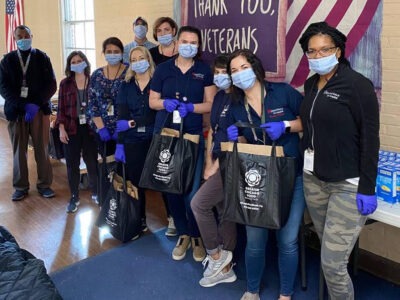Note: this piece has been cross posted and authored in partnership between CS and IHI.
Ending homelessness is not the job of a single sector — it’s the job of an entire community. In Sacramento, California, four regional health systems are committed to becoming a part of the collective, community-wide system that can help reduce chronic homelessness.
Dignity Health, Kaiser Permanente, Sutter Health, and UC Davis Health have partnered with Sacramento Steps Forward on a pilot supported by Community Solutions and Institute for Healthcare Improvement to help reduce and end homelessness at a population level. Sacramento Steps Forward is the lead agency of the local Continuum of Care, which has been working alongside Sacramento County and the City of Sacramento to reduce homelessness.
“We have been embracing a critical change to make sure that all of our efforts are aimed at reducing homelessness,” said Lisa Bates, the CEO of Sacramento Steps Forward. “The strength of this community has been historically rooted in the dedicated agencies and organizations, which deliver excellent programs. We are knitting together those efforts — and this new partnership — into a strong, coordinated system of response that defines our collective success by whether we are getting closer to zero homelessness.”
By harnessing their unique position at the cross-section of care delivery and public health, health systems are supporting the community-wide efforts to achieve these goals.
“It’s exciting that Sacramento’s four health systems are doubling down on our collective commitment to help drive measurable reductions in homelessness in our community, while improving both housing and health outcomes for those experiencing homelessness,” said James ‘Jay’ Robinson, who is Kaiser Permanente Sacramento and South Sacramento Senior Vice President and Area Manager.
“This started with deepening our relationship with Sacramento Steps Forward and the Sacramento Continuum of Care to better understand the needs of our local homeless response system,” Robinson said. “Doing so has already helped us make more informed, systems-level investments that have increased the capacity of the broader homeless response system in Sacramento County.”
From Programs to Systems
Historically, the four regional health systems have worked together to address homelessness by helping to develop and invest in effective programs such as Whole Person Care, Medical Respite, and the Triage, Transport, and Treatment Program.
While these programs were important, the pilot participants recognized an opportunity to partner differently with homeless serving organizations and agencies, as well as the broader Continuum of Care in Sacramento County.
They aimed to understand what systems approaches might yield the greatest impact in reducing chronic homelessness, improving long-term health and housing outcomes for people experiencing chronic homelessness, and achieving greater value for community investments.
“Collaboration across multi-sectors is vital when aiming to make transformational changes within our regional system to serve our unhoused neighbors,” said Michael Korpiel, the President of Dignity Health Mercy San Juan Medical Center and Greater Sacramento Market President.
The pilot participants began to do a deep dive into their own hospital discharge and care support processes, reviewed community benefits investments across all four systems and their resulting impact on reducing homelessness, and conducted an in-depth analysis into how the homeless response system currently operates and interacts with the health system.
“Dignity Health and our other health systems in the Sacramento market remain committed to working with Sacramento Steps Forward and our homeless service providers to improve the Continuum of Care and ultimately resulting in all of our communities having stable, safe and affordable housing,” he said.
Improving Quality Data
“Research shows social and economic drivers affect health outcomes and costs in significant ways. By working together, we can help address these factors and improve health in a sustainable, cost-effective manner while better meeting the specific needs of each individual person.”
Dr. David Lubarsky
One key area of opportunity was to improve the exchange of data between health systems and the Homeless Management Information System (HMIS).
By sharing data, they sought to improve coordination for housing and health services for the population, support accelerated housing placements, and improve health outcomes. To fully realize this potential, the pilot participants had to work together to develop data-sharing agreements and protocols across the Continuum of Care and health systems. These are currently under review.
The health systems have also incorporated performance measures tied to overall reduction in chronic homelessness, including housing placement timeframes, access to services, and overall reductions in hospital utilization for non-acute care.
“With closer monitoring and measuring of more outcomes through shared data and care coordination across health systems, we can better work together to deliver comprehensive care, including connecting patients with the additional health care and social services they need,” said Dr. David Lubarsky, the CEO of UC Davis Health.
Increasing Participation and Investment
The coordinated access system refers to the homeless response system that identifies and supports people so that they can exit homelessness. The strength of this system depends on many factors, including the number of participating service providers, how well the population of people experiencing homelessness is understood, and the capacity of the system to respond to the data it collects.
The health systems are strengthening their participation in, and support of, the coordinated access system. They are standing up a centralized model to link patients who are experiencing chronic homelessness and identified as regular users of the emergency department to the broader homeless system of care. To improve health and housing outcomes, they are also developing a process map of emergency department triage and referral process for patients experiencing homelessness and inpatient discharge workflows.
The health systems also aim to leverage their own ability to increase participation and coordination by others. For example, the health systems will require any local homeless services providers to participate in the Continuum of Care’s system-wide approach to be eligible for funding from them. They have also jointly funded three new staff positions at Sacramento Steps Forward, which will support improved case conferencing and process improvements in the homeless response system, expand the agency’s capacity around policy and communications, and create a new Sacramento Funders Collaborative to leverage additional private and public funding into a system-wide approach.
“At the outset of the pilot, we asked ourselves, ‘What role can health systems own to effectuate systemic change that leads to real, visible, tangible, and lasting results?’” said Keri Thomas, the Vice President, External Affairs for the Sutter Health Valley Area.
“We are learning there are many opportunities — whether that is to be better coordinated in our community investments, enhanced triage support for patients experiencing homelessness, or to be a role model on how to leverage our health system knowledge to support improvements in the broader homeless response system.”
Healthcare and Homelessness Pilot
Community Solutions and the Institute for Healthcare Improvement are exploring how to help communities end chronic homelessness.




